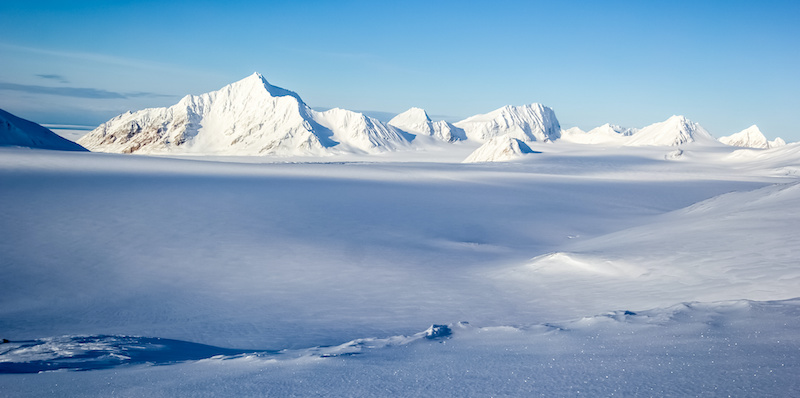One blue-sky day this past September, I stood at the edge of the Mer de Glace in Montenvers, above Chamonix. I had hiked there along the Balcon du Nord to meet my husband for coffee. Together, we gazed out at the glacier’s dirt-grayed surface cracked throughout with crevasses and stitched with snow bridges. I told him that the Mer de Glace appears in Mary Shelley’s Frankenstein, when the creature challenges Frankenstein’s moral obligation to the being he has brought into the world. We joked that we knew a bit about complicated bonds and obligations now, fresh from our recent experience of glacier climbing not far from where we stood.
We had just completed a trip whose mission had been to reach the summit of Mont Blanc. But the climate-affected route had become more risky and more technical than our group of climbers was ready for, and so our guides had switched our objective to Monte Rosa. There, as on an earlier training climb, we were turned back by weather, facing dangerously high winds on one climb and lightning on the other.
Now, with the trip behind us, my husband and I drank our coffees and wrestled with the frustration of having reached no summit, despite knowing the guides had made the right decisions. I had been so restless with disappointment I had launched myself into the eight-mile round trip at near-running pace, simply to remember I could move with purpose in the mountains.
As I looked out that day at the Mer de Glace, it made such sense to me that glaciers would be the setting for harsh questions of ethics and personal responsibility. Tinted in various hues of gray and white and blue, a glacier still feels overwhelmingly white, its expanse offering no shelter and little easy escape. You cross a glacier roped to others in your group. One climber’s too-quick step can tug you off your feet. Another’s lag can leave a loop in the rope that you might trip over. Thanks to the stress of altitude and effort, your companions’ every decision takes on enormous importance. It’s not a stretch to say a small decision can set everyone’s life at stake.
That’s what had drawn me to the challenge of Mont Blanc in the first place. For as long as I can remember, I’ve viewed winter landscapes as the backdrop, the opportunity, for tests of character. An only child, a skier, a reader of adventure stories, I was serious about my snow. When, at age seven, I saw a documentary about Robert Scott, I imprinted on his tale of snow-bound endurance like a duckling. The story of his race against Roald Amundsen to be first to the South Pole seemed to me the most compelling adventure story of them all, and Scott, even in failure, the greatest hero.
I likely owe my interest in Scott to the quality of his storytelling. Self-consciously crafting even his most anguished declarations, Scott employed literary devices and tropes as he recounted the experience of his Polar Party. In his final missive, he used a fascinating conditional about his own death: “Had we lived,” he wrote, “we would have had a tale to tell”[1].
For years I wanted to write something about Scott, something about what it must have felt like for him to see the Norwegian flag and know he had been beaten. I wondered how a person would respond, morally, to such a situation, in the stark landscape of the Pole that would seem to afford as little ethical ease as bodily comfort. What more would Scott have said, if he had lived to tell the story of his own survival? How would his tale have matched up against Amundsen’s? Or against the truth–if such a thing can be verified when one is alone on the ice? What recriminations might each man have uttered if he had been compelled to share the stage not only in the race but once the race was done? Since Scott couldn’t tell the tale–but didn’t he?–I found a way to tell it for myself, in my new novel Terra Nova, with two invented explorers who can’t exist without each other.
As the idea for my novel came together, I was intent on staying away from the many narratives of Polar expeditions, lest my writing be too influenced by theirs. I thought instead of Mary Shelley’s Frankenstein, and of the way she set her ethical questions against a backdrop of forbidding snowy landscapes. By the Mer de Glace, on the ice floes of the Arctic, and on Mont Blanc itself, Shelley sets a stark moral combat between a creator and a creature who desperately depend on each other just as much as they seek each other’s destruction. The novel captured what interested me most about a story set around the South Pole. My two fictional explorers would be bound together like Victor Frankenstein and his creature–in survival, in fame, and perhaps in ignominy.
Frankenstein’s Miltonian questions–heralded by the epigraph from Paradise Lost–unfold like questions of pure morality, stripped of context or contingency and as bare as the glacial surface.
Did I request thee, Maker, from my clay
To mould me man? Did I solicit thee
From darkness to promote me?
Paradise Lost, Book X 743-45
Shelley gives us a tale of opposites bound inescapably together, of two individuals who are each the creation of the other. Without Victor Frankenstein there would surely be no monster; and the narrative makes clear that without the monster, Frankenstein himself would collapse into formlessness.
Frankenstein’s story begins when he ponders the question “Whence . . . did the principle of life proceed?” He moves on to believe that “A new species would bless me as its creator and source.” But once his creature’s vengeful anguish has led him to kill two people, Frankenstein flees his creation–or thinks he can. He cites the lines in Coleridge’s The Rime of the Ancient Mariner that echo this notion of the inescapable pursuer:
Like one who, on a lonely road,
Doth walk in fear and dread,
And, having once turn’d round, walks on,
And turns no more his head;
Because he knows a frightful fiend
Doth close behind him tread.[2]
In his flight from the monster, Frankenstein arrives at Montanvert [sic] and goes from there onto the very Mer de Glace I stood above in September. “The field of ice is almost a league in width, but I spent nearly two hours in crossing it,” he says. “The opposite mountain is a bare perpendicular rock,” he says, accurately describing the Aiguilles du Dru. From where he stands, “above [Montanvert] rose Mont Blanc, in awful majesty.” He goes on:
The sea, or rather the vast river of ice, wound among its dependent mountains, whose aerial summits hung over its recesses. Their icy and glittering peaks shone in the sunlight over the clouds.
*
Frankenstein’s vision of this sublime frozen expanse is troubled by the creature he cannot escape. “I suddenly beheld,” Shelley writes, “the figure of a man, at some distance, advancing towards me with superhuman speed. He bounded over the crevices in the ice, among which I had walked with caution.” A confrontation follows, between creature and creator, centering on each one’s moral obligations–to society and to the other. As the creature puts it, “you, my creator, detest and spurn me, thy creature, to whom thou art bound by ties only dissoluble by the annihilation of one of us.” The two are both “enemies” and yet there is, contrary to what Frankenstein asserts, “community between [them]”.
Shelley has framed the whole novel with this idea of inescapable pairing. Frankenstein begins with a letter from Robert Walton to his sister, telling her of his imminent departure for the North Pole. Looking out from his ship, Walton sees “stretched out in every direction, vast and irregular mountains and plains of ice”. In this stark setting, evocative of the Mer de Glace, Walton spies “a low carriage, fixed on a sledge and drawn by dogs, pass on towards the north . . . a being which had the shape of a man, but apparently of gigantic stature”. This is, of course, the creature. The next day, when the sailors intercept a sledge on the ice, it turns out to be Frankenstein himself they rescue. His purpose: “‘To seek one who fled from me.’”
In this event that takes place at the end of the story’s chronology, we see Frankenstein still in tortured connection to the monster, and Walton as well caught up now in a new bond, as he becomes compelled to hear out Frankenstein’s strange tale. Here, as in the Mont Blanc scene, snow and ice and cold serve as the stage on which Shelley’s moral actors play out their questions. Walton’s need for friendship, stated often in his letters to his sister, is held up for comparison with Frankenstein’s treatment of the monster, and the monster’s own needs for companionship. What are the limits of these personal and social connections, Shelley’s novel asks? What should those limits be?
Like the figures in Shelley’s novel, Scott and Amundsen might as well have been roped together, so tied were they to each other’s identity and existence. The binary of their competition–one wins, one loses–forged a more particular individuality for each of them. Scott responded with stoicism to Amundsen’s victory: “The Norwegians have forestalled us and are first at the Pole. It is a terrible disappointment, and I am very sorry for my loyal companions.” But the forced cheer of the day’s entry in his journal betrays a sense of loss deepened by his intimate knowledge of the rival’s experience. “The tent is fine–a small compact affair supported by a single bamboo,” he writes of Amundsen’s Polar shelter. “A note from Amundsen, which I keep, asks me to forward a letter to King Haakon!” Even in Amundsen’s success and Scott’s defeat, it was not certain which of the two would survive to tell the tale.
Scott’s own experience was the near double of Amundsen’s–except for the tragic fact that Amundsen got there first. I imagine the two of them moving in almost parallel lines from north to south, invisible to each other, but always existentially connected, just like Frankenstein and the creature on the Arctic ice.
For years before arriving in Chamonix, I had been looking forward to the Mont Blanc trip as an opportunity to face in my own life a tiny version of the challenges I’d set for my fictional explorers. That day by the edge of the Mer de Glace, I still had no answer for the questions raised by all that ice and snow. What were the limits of trust–of each other, of our guides? Could I have mastered my greater fears on Mont Blanc’s harder route? Or were these substitute journeys the toughest I could do? As we had crossed the occasional snow bridge not much wider than our crampons, what had the guides been thinking? Should we go on? Were we ready to go on? Could some have gone on without the others?
It seems so simple, to know which bonds to cut and which to knot tighter, to know when to continue and when to walk away. But it’s not simple at all. And it seems clear to me now that the clarity of the choices, as Shelley articulates them against the stark white backgrounds, would diminish the allure of exploration. Frankenstein even confirms as much, with the impossibility of its hoped-for resolution. With Scott and Amundsen, too, what holds our fascination over a century later, is the ambiguity of their situation, not the clarity. Yes, Amundsen got to the South Pole first, but did only one team win, and who told the better story?
[1] Robert Falcon Scott, Scott’s Last Expedition, The Folio Society, London (1964)
[2] In Coleridge, too, the setting for this terrible companionship is the Pole–specifically the southern sea where, “The ice was here, the ice was there,/The ice was all around:/It cracked and growled, and roared and howled,/Like noises in a swound!”
***


















